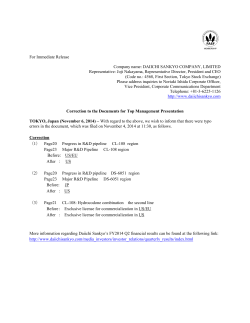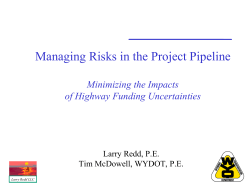
ENERGY SECURITY IN SOUTH EAST EUROPE: THE ROLE
Analysis No. 282, January 2015 ENERGY SECURITY IN SOUTH EAST EUROPE: THE ROLE OF THE SOUTHERN GAS CORRIDOR Emin Akhundzada South East European (SEE) countries represent small-scale markets. Natural gas is a new source of energy for these countries, some of which lack even the basic natural gas infrastructure, including Albania, Kosovo and Montenegro. Due to the region’s infrastructure deficit, natural gas penetration rate is much lower than in other European countries. Currently, the region can cover around 37% of its gas consumption through indigenous production. The rest is imported almost entirely from Russia. The situation is better only in two countries: Romania and Croatia, which can meet a significant proportion of national demand through domestic production. Bulgaria and Serbia are also able to meet a small proportion of local consumption through domestic production. Natural gas consumption in South East European countries is expected to increase. In this regard, the region faces both opportunities and challenges ©ISPI2015 Emin Akhundzada is Academics & Research Coordinator at Caspian Strategy Institut 1 The opinions expressed herein are strictly personal and do not necessarily reflect the position of ISPI. The ISPI online papers are also published with the support of Cariplo South East European (SEE) countries represent small-scale markets. Natural gas is a new source of energy for these countries, some of which lack even the basic natural gas infrastructure, including Albania, Kosovo and Montenegro. Due to the region’s infrastructure deficit, natural gas penetration rate is much lower than in other European countries. For example the gasification rate in Bulgaria is less than 2% in households which average rates in European Union is between 27%-50%1. Currently, the region can cover around 37% of its gas consumption through indigenous production. The rest is imported almost entirely from Russia, which poses a huge challenge for these countries in terms of single supplier dependency. The situation is better only in two countries: Romania and Croatia, which can meet a significant proportion of national demand through domestic production. The region’s total natural gas consumption was 26 bcm in 2012, 10.9 bcm of which was produced by Romania2, and 2 bcm by Croatia. Bulgaria and Serbia are also able to meet a small proportion of local consumption through domestic production. Natural gas consumption in South East European countries is expected to increase to 44 bcm by 2025, and 50 bcm by 2030. In this regard, the region faces both opportunities and challenges Opportunities in South East Europe 1. Population growth is higher in this region than in the rest of Europe. Population growth in the EU is projected to slow down dramatically, particularly after 2025, and the young population is expected to decrease. This will likely have a negative effect on the labour force, and accordingly, the EU’s economic development. However this is not the case for SEE countries. The young population is growing in this region, which will boost its economic development. 2. The SEE economies are expected to reach 2.5% annual growth rates, while European average growth is projected at around 1.5% per year up until 2030. Economic growth in Alternative energy for clean nature”, Bulgarian Association Natural gas, http://www.naturalgas.bg/infoen/9 ( accessed on January 28, 2015) 2 BP Statistical Review of World Energy June 2013, p.24, http://www.bp.com/content/dam/bp/pdf/statistical-review/statistical_review_of_wo rld_energy_2013.pdf ©ISPI2015 1 2 South East Europe will also trigger the growth of the natural gas market. Furthermore, given that the SEE markets are still relatively undeveloped, there is significant potential for foreign investments, particularly in the energy sector, notably for the development of the necessary infrastructure components. 3. The region has significant renewable energy capacity. For example, Albania can generate almost 100% of its electricity needs through hydro energy. As a net exporter of electricity, Bulgaria can generate a significant proportion of its electricity from hydro energy. Challenges in SEE 1. The region is poor in terms of oil and gas resources. Some of the region’s countries are 100% dependent on oil and gas imports. Moreover, most of those countries are dependent on a sole supplier, namely Russia, which poses a threat to their energy and supply security. Given their dependence on a single supplier, there is no competition in these markets. As a result, they buy natural gas at the highest prices in Europe. This also triggers their current deficit. 2. The region lacks natural gas infrastructure and transmission systems. Consequently, these countries mainly consume carbon intensive energy fuels, particularly coal, which is not an environmental friendly fuel. 3. Some countries such as Serbia, Kosovo and Macedonia are landlocked. Thus, they do not have the LNG option as a means of ensuring their supply diversification; they can only purchase natural gas via pipelines. Southern Gas Corridor as a Solid Project ©ISPI2015 The Southern Gas Corridor (SGC) project is a mega gas pipeline project that aims to transport Caspian natural gas to Europe. The project is composed of 4 components. 1. 2. 3. 4. 3 Shah Deniz II Natural Gas Field South Caucasus Pipeline (SCP) Trans Anatolian Natural Gas Pipeline (TANAP) Trans Adriatic Pipeline (TAP) The Shah Deniz natural gas field is one of the world’s largest natural gas fields, and the largest in Azerbaijan. It is located 70 km from Baku in the offshore section of the Caspian Sea. It holds almost 1.4 trillion cubic meters of natural gas. Shah Deniz I, the first stage of the Shah Deniz field, has been operational since 2006 and produces 9 billion cubic meters of natural gas per year3, of which almost 6.6 bcm is delivered to Turkey. Shah Deniz II, the second stage of the Shah Deniz field, is a major source base and the upstream part of the Southern Gas Corridor. It is expected that the Shah Deniz II field will be operational by 2018. The project will supply natural gas to the European market directly from Azerbaijan for the first time, opening the Southern Gas Corridor. As part of the project, 25-year sales agreements were reached on September 19, 2013 for over 10 billion cubic meters of natural gas per year from the Shah Deniz II field. Nine companies will buy this gas from Italy, Greece and Bulgaria4. The Final Investment Decision (FID) was signed on December 17, 2013 for the Shah Deniz II project5. The midstream part of the Southern Gas Corridor project has three rings: the South Caucasus Pipeline, TANAP and TAP, the total length of which will be 3500 km. The length of the SCP pipeline is 691 km, with 443 km in Azerbaijan and 248 km in Georgia. It starts in Azerbaijan’s Sangachal terminal and ends at the Georgia-Turkey border. As part of the Shah Deniz Project, the SCP will be expanded. The expansion will entail laying a new pipeline through Azerbaijan and constructing two new compressor stations in Georgia6. This will triple the gas volume transported via the pipeline, reaching over 20 billion cubic meters per year. See BP website, http://www.bp.com/en_az/caspian/operationsprojects/Shahdeniz/ SDstage1.html (accessed on january 28, 2015. 4 See BP website, “Shah Deniz Major Sales Agreements with European Gas Purchasers Concluded”, http://www.bp.com/en/global/corporate/press/ press-releases/shah-deniz-major-sales-agreements-with-european-gas-purchasers -c.html (accessed on January 28, 2015). 5 See BP website, “Shah Deniz Final Investment Decision Paves Way for Southern Corridor Gas Link with Europe”, http://www.bp.com/en/global/corporate/ press/press-releases/shah-deniz-final-investment-decision-paves-way.html (accessed on January 28, 2015). 6 See BP website, “South Caucasus Pipeline”, http://www.bp.com/en_az/ caspian/operationsprojects/pipelines/SCP.html (accessed on January 28, 2015) ©ISPI2015 3 4 TANAP will start at the Georgia-Turkey border and end at the Turkey-Greece border, passing 20 cities on its route through Turkey. With regard to its technical features, at 56 inches in diameter, it is the second largest pipeline in the world. Its annual capacity will be 31 bcm, expandable to 60 bcm7. The Environmental Impact Assessment report (EIA) for TANAP has already been released8, and the ground-breaking ceremony of the project is scheduled for April 2015. TAP is the final step of the Southern Gas Corridor project: starting at the Turkey-Greece border, it will pass through Greece and Albania, under the Adriatic Sea, ending in southern Italy. The capacity of the project will be 20 bcm, and is also expandable. TAP has received EIA reports from Greece and Italy9. Map of Southern Gas Corridor Source: Caspian Strategy Institute “Turkey to Increase its Stake in TANAP”, Daily Sabah, May 29, 2014 http://www.dailysabah.com/energy/2014/05/30/turkey-to-increase-its-stake-in-tan ap ( accessed on January 28, 2015). 8 “TANAP için ÇED Raporunun Nihai Kabulü Yapıldı”, http://energyworld.com.tr/tanap-icin-ced-raporunun-nihai-kabulu-yapildi.html (accessed on January 28). 9 Italy, Greece approve TAP environmental Studies, http://www.neurope.eu/article/italy-greece-approve-tap-environmental-studies (accessed on January 28, 2015). ©ISPI2015 7 5 As this brief has demonstrated, the Southern Gas Corridor project is a well-planned and promising initiative that will significantly contribute to the energy and supply security of European countries. But this project is particularly important for the SEE countries, given their single supplier dependency. So, what will Southern Gas Corridor bring to South East Europe? Importance of the SGC for SEE countries 1. The total gas demand of SEE countries is expected to increase from 26 bcm in 2012 to 44 bcm by 2025. TAP can supply the additional gas required to meet this growing demand. 2. The Russia-Ukraine gas crises have increased the importance of access to new and reliable gas sources for SEE. TAP represents a reliable gas supply for these countries. Through the Ionian Adriatic Pipeline (IAP), TAP can bring natural gas to Bosnia and Herzegovina, Serbia, Kosovo, Montenegro and Croatia, and to Bulgaria and Romania via the vertical interconnector project, namely the Greece-Bulgaria-Romania interconnectors. ©ISPI2015 Map of Ionic Adriatic Pipeline 6 3. 4. 5. 6. 7. ©ISPI2015 8. 10Gas TAP can provide natural gas to countries such as Albania, Kosovo and Montenegro, which lack an indigenous natural gas market. TAP can pave the way for developing the natural gas markets of SEE countries by constructing networks, transportation systems and interconnectors among themselves. These projects are also a part of the EU’s final energy package, aimed at creating an internal gas market. The SEE countries need to be ready for the possibility of supply disruption, which caused major problems when Russia cut off the natural gas flow to Ukraine in 2006 and 2009. In the event of a future disruption, TAP can activate its reverse capacity and provide natural gas to this region. Given that countries such as Macedonia, Kosovo and Serbia are landlocked and therefore cannot construct LNG terminals to provide supply diversification, they can only buy natural gas via pipelines. TAP can provide natural gas to those markets to ensure their energy security. The SEE countries are also at a disadvantage in terms of natural gas import prices. In 2012, Macedonia purchased the most expensive gas from Russia (USD 564.3), followed by Bosnia and Herzegovina (USD 515.2), Bulgaria (USD 501), Greece (USD 476.7) and Serbia (USD 457.3)10. TAP will ensure diversification for these markets and create a more competitive environment. Russia’s monopoly over gas supplies will be eliminated, and prices will decline accordingly. Some SEE countries are highly dependent on carbon intensive energy resources to meet their energy needs, especially oil and coal. Moreover, these countries are aspiring EU members, which increase the importance of achieving a more environmentally balanced energy portfolio. The import prices in these countries are high due to their dependency on a sole supplier, and so they cannot substitute coal with natural gas. Given that TAP will provide a competitive environment in these countries and prices to SEE countries are cited from: Izvestia, A map of prices of Gazprom in Europe, http://rbth.co.uk/multimedia/infographics/2013/02/08/a_map_of_prices _of_gazprom_in_europe_22639.html 7 trigger a decline in natural gas import prices, they can easily substitute coal with natural gas. 9. Most of the SEE countries are suffering from a high trade deficit due to high natural gas import prices. Taking into account that the prices will drop with competition, national energy bills will decrease, which in turn will cause a boom in their manufacturing industries. Moreover, low import prices will reduce costs in energy-intensive industries and attract foreign direct investment. The increase in production will also reduce unemployment. In conclusion, SEE countries face both opportunities and challenges. The population growth of the region offers a significant advantage, and its economies are growing faster than the rest of Europe. Although the markets in the region are small and relatively undeveloped, they are undergoing rapid growth. The region is rich in renewable energy capacity, particularly hydro, and the young population is another important advantage. However, there are also several challenges in the region. They are poor in oil and gas resources, and import almost 63% of their total oil and gas demand. With regard to natural gas, they depend on a single supplier, which creates a monopoly. Some countries, such as Bulgaria, Macedonia, Bosnia and Herzegovina, are almost 100% dependent on Russian natural gas. Due to this single supplier dependence, they consume the most expensive natural gas in Europe. High natural gas import prices also hinder the development of natural gas markets, obliging them to use cheaper carbon intensive fuels. ©ISPI2015 By bringing natural gas from alternative sources and suppliers, the Southern Gas Corridor, particularly the Trans Adriatic Pipeline, will significantly improve the energy and supply security of the region. With the entrance of a new supplier into these markets, the Russian monopoly will be eliminated and import prices will decrease. In turn, this will create a downtrend in the trade deficit of these countries and boost their economies. 8
© Copyright 2025













